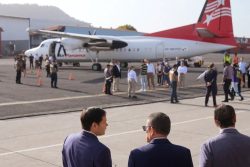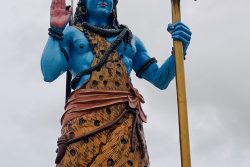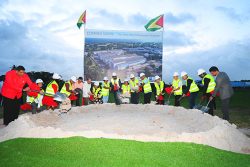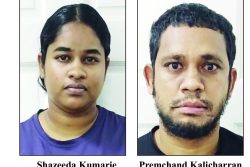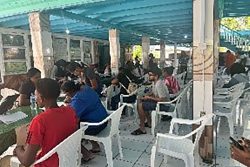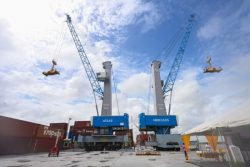Story and photos by Alva Solomon
By 9 am on any given morning the Region One mining community of Port Kaituma is buzzing with activity as a variety of vehicles plough through the narrow slushy roads at the Waterfront. Men with muddied clothes and tall galoshes, some eating a snack while preparing to venture into the fields, talk about their numerous experiences and their hope of striking the ore once again.
Gold mining has seen the population of the North West District (NWD) community climb sharply in recent years. Everyone here is in search of the abundant benefits from the metal which has brought both good and bad to the area.
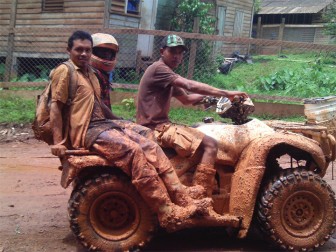
Port Kaituma is one of the six districts across the country which has seen a rise in various economic activities relevant to the mining sector. Regardless of the day of the week, each of the average 500 persons who crisscross each other’s path at the Waterfront is on a mission to reap the benefits of the mining industry.
The area is referred to by residents and miners as the gateway to North West’s El Dorado. It is the starting point of each activity. The ferry, MV Lady Northcote, hired barges and other boats all moor here at various times of the week, day and night with loads of mining equipment, food stuff, beverages and a variety of the late models of vehicles in the country. The latter may appear a strange sight to any first time traveller when one considers the horrid state of the roads.
Miners have turned businessmen and everyone at Port Kaituma can provide a history of the activities which culminate there and end as far as the Black Banana backdam, which is one of the last geographic mining areas in the North West District heading west to the Venezuelan border. Matthew’s Ridge, another mining community in Region One known for its manganese ore, sits in the middle of the journey for those who own mining claims and permits heading to the Black Banana area.
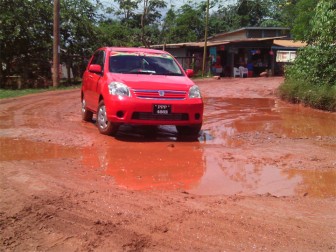
Speaking to Stabroek News during a recent visit to the area, roadside vegetable vendor/dredge owner Gail (only name given) is one of the many persons who have been added to the mining population in the NWD in recent months. Gail said that she and her family previously lived a normal life on the coastland and while selling clothes and other dry goods in the city had been able to take care of the family’s everyday needs, the price of gold saw her moving to Port Kaituma in search of wealth.
The young mother told Stabroek News that she had been visiting the area since 2009 to transact business. She said her relatives have been living in the area for years but she decided to invest in her own mining equipment and subsequently a business in order to capitalise on the business opportunities available.
She said she owns and operate a 4-inch dredge, one of the smaller machines as compared to the 8-inch dredge which has a higher output as well as resource consumption such as gas.
Gail noted that like many persons in the community, her business is two fold. She sells a variety of vegetables which end up in the backdam. On the other hand, she manages the dredge operation which she noted can be a tedious task given the planning needed to ensure the machine brings in a profit.
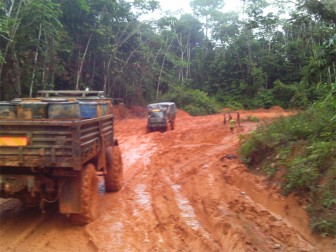
She said the dredge employs a number of persons and the payments vary depending on the output “when we wash down”.
She informed that the cook or ‘bahir’, collects a fixed salary of $160,000 per month on a 4-inch dredge, or $200,000 per month on an 8-inch dredge.
“The jetman and other persons working on the dredge might get far more or might get less depending on how much they make off the dredge… The workers get a percentage of the gold and that could be like about $200,000 to as much as $600,000,” Gail said. She added that “this is only [for] one wash down so on a monthly basis a miner could get some nice money and that’s why ya have all these men wha ya seeing here at Kaituma.”
Meanwhile, “if nothing is made, the worker may move on to another dredge or he might stay so it depends.” She said that this happens on a few occasions, especially during bad weather when the backdams are usually flooded. In such cases the dredge operator suffers since he or she may have invested hundreds of thousands of dollars in the operation. She said that the operator would have spent huge sums sourcing goods such as ration and spares as well as on transportation to the backdam, the cost of which increases during bad weather. Goods are taken to the backdams via road and then in some cases, onward to areas such as Eclipse Falls on the Barima River, by boat. This is referred to as a double charter and can cost as much as $700,000 depending on the distance along the river.
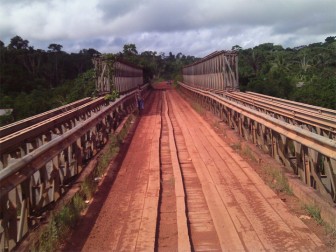
“If it rains… we expend a lot of money… because we had to move engines from one place to a next and the cruiser (four-wheel drive vehicles) drivers would dig a hot price in you when you have to move a dredge.Because the first thing they ask is if the road bad or not,” the woman miner said.
At Matthew’s Ridge this newspaper spoke to miner Jacob Peters, one of several passengers who sat in a minibus waiting to leave for the Baramita area. The 2-hour journey costs each passenger some $10,000 but the price may increase with the load the passenger may be carrying along.
Peters was heading into the mining area of Five Star, having travelled from Port Kaituma months earlier to a mining operation along the 40-mile journey between the two mining communities. He said he worked for several months at a mining operation at Eclipse Falls, located some 20 miles south west of Port Kaituma along the way to Matthew’s Ridge.
According to him, “I get a link up from a pardna up by Five Star and it paying better so that’s where I going now with my girlfriend.”
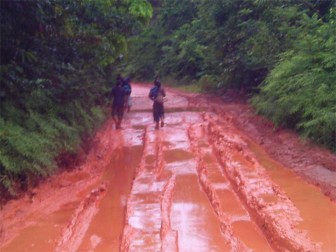
He said his relocation would not hurt his previous employer since there is always another miner available at Port Kaituma who is ready and who would be willing to take his place. “Ya see is de money people going behind so if a man get a offer… It ain’t matter how much really but once is something he could do wid he going for it,” he said.
He noted that the Five Star area is filled with dredge operations and is one of the more populated mining areas in the NWD.
According to miners at the Port Kaituma Waterfront, the activity has several spin-offs which see money being turned over almost daily at the busy community.
The increase in private cars in the area, even the most recent models which have arrived in the county, are evidence of the ‘gold rush’. Taxi drivers charge a standard fee of $1,000 regardless of how short the distances requested by passengers may be. This also occurs at Matthew’s Ridge and as far as the remote Arakaka mining community, another increasingly populated area between Matthew’s Ridge and Port Kaituma.
There are also several roadside vendors selling various goods but the most popular and recent are the food stalls whose delicacies are sold out within a 2 to 4-hour time span. An increase in spare parts dealers, private transportation services heading to the backdam areas, hotels as well as goldsmiths have all resulted from the ‘gold rush’ in the area.
But while gold mining has made many rich and even famous in the NWD, there are many disadvantages which the activity has taken to the area. One such negative is crime and according to miner Claudius John, there is need for better manned and equipped checkpoints along the routes leading to the backdam. “We had about 3 to 4 robberies in this North West area recently and we also had some murders. [One of] the more recent [involved] the girl who get chop up at Big Creek,” he stated. According to John, there are police stations in the main communal areas. However, there are no checkpoints along the main routes leading to the backdam.
A police official at Port Kaituma noted that the lack of resources such as vehicles have been a major bugbear facing lawmen in the area. He said there are corporate entities that are willing to assist the force, but noted that this can bring challenges.
Some dredge owners have been hiring their own security staff and this is seen as being beneficial to more than one mining operation in an area. According to the miners, there are some among them who travel to the mining areas under the pretext of working for the gold and at an opportune time, may commit robberies, not necessarily in the vicinity.
“Dese chaps sem now does be working as a crew and when dem think dey know enough about a man movement dey going in and tek he ting,” a Matthew’s Ridge miner stated. He said in some cases miners have discovered that there are middlemen, such as those providing transportation services to and from the mines who are in cahoots with the bandits. He recounted an incident this year in which brothers Trevor and Cleveland Smithet were ambushed along a trail in the Five Star area.
Trevor succumbed to gunshot wounds which he sustained when he and his brother were robbed and the surviving brother had informed this newspaper that the robbery was “a set-up” by men on a bike who they had hired to transport them out of the area.
There are also health related issues. A health official at Arakaka told Stabroek News during a recent visit to that area that as many as 15 positive tests for malaria are recorded on a daily basis in that community. She said the figures are similar in other mining areas in the region. On one day at Arakaka, she said, “We went into the mining camps and do tests and while checking them after of about 68 tests done… 20 [people] had malaria.”
She said that in some cases the persons were manually carrying out their duties while those in a more affected state lay recovering in their hammocks.
Miners continue to throng the mining pits across the country this year and gold production has risen sharply compared to the same period last year.
The Stabroek Business reported recently that gold production could be heading for another record this year, with the Guyana Geology and Mines Commission (GGMC) announcing that first quarter declaration had reached 88,873 ounces, exceeding the first quarter of 2011 by 10,864 ounces or 14 %.
